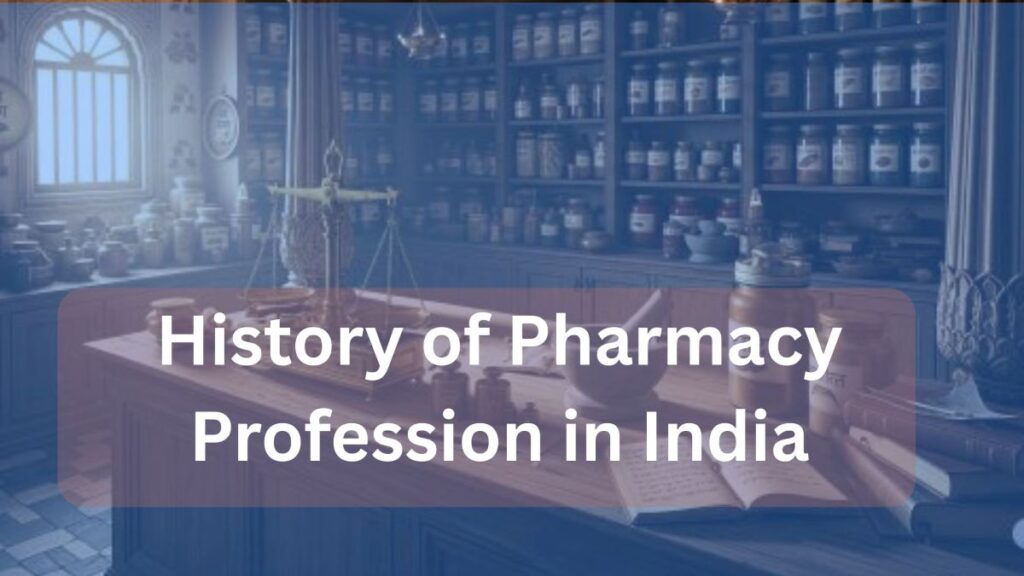The pharmacy profession in India has evolved through centuries, from the traditional herbal practices of Ayurveda to the sophisticated pharmaceutical sciences of today. India, known for its rich history in medicine, has seen a transformative journey in pharmacy—from healers and herbalists to licensed pharmacists and pharmaceutical scientists. In this blog we can explore the history of the Pharmacy profession in India by its different milestones and transformations that have shaped pharmacy into a vital healthcare discipline in India.
Early Beginnings: Traditional Medicine
India’s pharmaceutical roots can be traced back over 3,000 years to the Ayurvedic system of medicine, documented in texts like the Charaka Samhita and Sushruta Samhita. Ancient practitioners, known as Vaidyas, were skilled in preparing and dispensing herbal medicines tailored to individual patient needs.
Key highlights of this period include:
- Use of natural herbs, minerals, and animal products.
- Detailed descriptions of drug preparation, dosage, and preservation.
- Emphasis on personalized medicine (Prakriti-based treatment).
Other traditional systems like Siddha, Unani, and Tibbi also contributed to early pharmacy practices in India.
Colonial Time History of Pharmacy Profession in India
The pharmacy profession in India underwent significant transformation during the colonial period under British rule, shaping its modern foundation.
Key historical events include:
- 18th Century Introduction of Western Medicine: The East India Company established apothecaries to serve European settlers, introducing Western pharmaceutical practices. These apothecaries dispensed medicines and trained local assistants, marking the initial integration of colonial medicine into India.
- Establishment of Medical Institutions: In 1785, the British founded the Medical College of Bengal (now NRS Medical College), which included pharmacy training. This institution laid the groundwork for formal pharmaceutical education by training compounders and dispensers.
- Apothecaries Act Influence (1815): The British Apothecaries Act of 1815 influenced India, encouraging the regulation of drug preparation and dispensing. This led to the appointment of licensed apothecaries in major cities like Calcutta, Bombay, and Madras.
- Drug Import and Regulation: The 19th century saw increased importation of Western drugs, prompting the British to regulate their quality. The Bengal Pharmacy Act of 1874 was an early attempt to control drug standards, reflecting growing recognition of pharmacy as a distinct profession.
- Formation of Professional Bodies: By the late 19th century, the need for organized pharmacy led to the establishment of associations like the Bengal Chemists and Druggists Association (1888), advocating for better training and regulation.
These events during colonial rule bridged traditional Indian medicine with Western practices, setting the stage for the professionalization of pharmacy in the post-independence era.
Post-Independent Time History of the Pharmacy Profession in India
The pharmacy profession in India experienced remarkable growth and transformation after independence in 1947, aligning with the nation’s healthcare and industrial advancements.
Key developments include:
- Pharmacy Act of 1948: Enacted soon after independence, this legislation established the Pharmacy Council of India (PCI) to regulate education and practice, setting minimum standards for pharmacists and creating state pharmacy councils.
- Expansion of Pharmaceutical Industry: The establishment of the Indian Drugs and Pharmaceuticals Limited (IDPL) in 1961 marked the beginning of public sector drug manufacturing. The 1970s saw the rise of generic drug production, with India emerging as a global leader, supported by pharmacists in quality control and research.
- Indian Pharmacopoeia was first published in 1955 to standardize drug quality and formulations.
- Educational Advancements: The introduction of the Bachelor of Pharmacy (BPharm) and Master of Pharmacy (MPharm) programs expanded training opportunities.
- National Institute of Pharmaceutical Education and Research (NIPER): Founded in 1998, NIPER boosted research and education, producing skilled professionals for the growing industry.
- Regulatory and Global Integration: The Central Pharmacist Registration Number (CPRN) improved the global recognition of Indian pharmacists. Post-2000, pharmacovigilance and clinical research gained prominence, reflecting the profession’s evolving scope.
These milestones have solidified pharmacy’s role as a cornerstone of India’s healthcare system, driving innovation and public health improvements.
Modern Era Pharmacy Profession in India
The pharmacy profession in India has entered a dynamic modern era, marked by technological advancements, expanded roles, and global integration.
Key aspects include:
- Clinical Pharmacy Focus: The introduction of the Doctor of Pharmacy (PharmD) program in 2008 has emphasized patient-centered care, with pharmacists collaborating in hospitals for medication therapy management and counseling.
- Technological Innovation: Digital tools, including e-pharmacies and telepharmacy, have transformed drug dispensing and patient access. Artificial intelligence and data analytics are enhancing drug research and pharmacovigilance.
- Pharmaceutical Industry Growth: India, a global generics hub, continues to lead with companies like Sun Pharma and Dr. Reddy’s, employing pharmacists in research, development, and regulatory affairs.
- Public Health Contributions: Pharmacists play a vital role in vaccination drives, health awareness campaigns, and managing pandemics, as seen during COVID-19.
The modern era positions pharmacy as an important healthcare discipline, adapting to contemporary needs and shaping India’s pharmaceutical future.
Conclusion
The history of the pharmacy profession in India reflects a journey of transformation—from traditional Ayurvedic roots to a modern, regulated, and globally respected profession. As healthcare continues to evolve, Indian pharmacists are poised to play even greater roles in ensuring medicine safety, innovation, and patient care.



